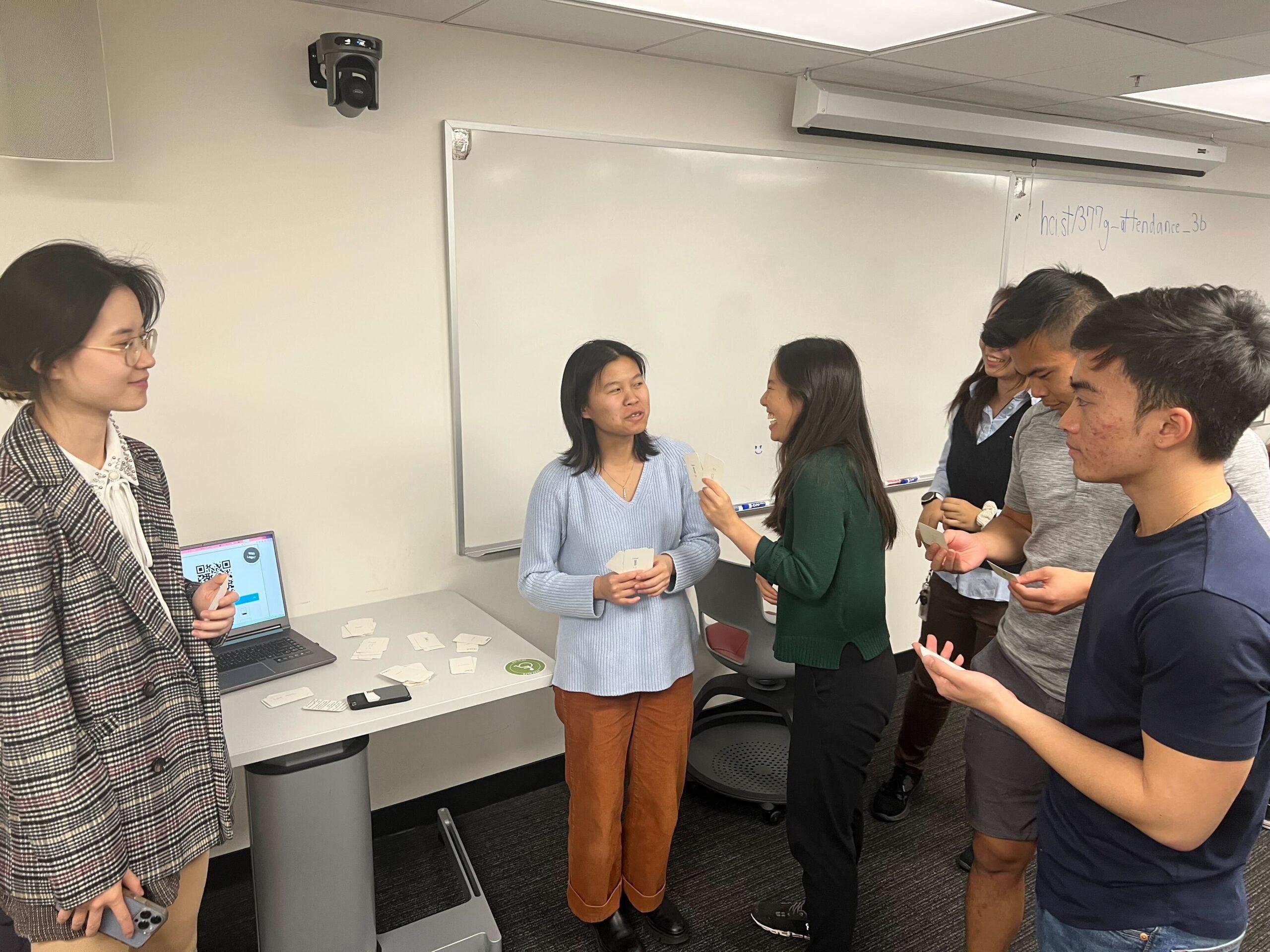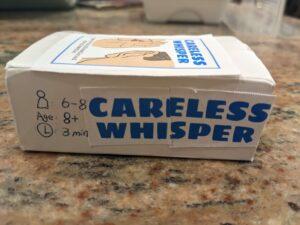Grace Zhang, Daniel Kim, Henry Summ, Lucy Lu


Final:
Overview: 250-500 words on your intent (Concept Statement as prose)
We live in the era where misinformation and disinformation plagues our information sphere across all forms of media. We all think we can discern information and be critical of its origin, but is that really true? We present to you a game where your information pipeline gets distorted and you need to find who is responsible for the disinformation to teach some ways misinformation and disinformation can be spread, meant for 6-8 players. We believe it will include several kinds of fun, focusing primarily on fellowship, challenge, and narrative.
Our learning outcomes are that players will be able to describe how misinformation and disinformation are spread and identify the sources of the distortion, and that they become more wary of information spread around the digital space, especially the information that have gone through many different rounds of circulation.. We will measure them by gauging qualitative player reactions and quantitative responses from survey results. We wanted to create this kind of game because we want to raise awareness of how easily misinformation can spread and improve people’s critical info assessment ability. We also want to show that there is naturally misinformation created as information spreads; furthermore, malicious actors can twist the information intentionally and create disinformation. Although this game is only a condensed simulation of how this may occur in the real world, we believe that the awareness and critical and intentional skills will help players go on and become more cautious in their own lives and in situations where the information being presented and analyzed are more important and relevant to the real world.
Games we drew inspiration from are Secret Hitler, Mafia, Codenames, and Operator. Our biggest concern is whether the game can be mathematically solved by a particularly intent player; fortunately it has not become a problem during multiple play tests.
Photos of “Packaging” (Optional for 2% extra credit on the assignment)



Rules –
- All players will draw a role card from the Secret ID deck. This will tell you if you are a disinformant or a civilian whisperer.
- All players will draw a role card from the Online ID (Online Persona) deck. This will tell you the rule for the persona you are supposed to follow throughout the game and when you transfer information.
- Players will distribute Order cards amongst themselves.
- 3 rounds of Information Transfer will now take place.
- Information Transfer
- The person who draws Order card 1 will be the initial message creator and start to distribute the message.
- The first person will draw 4 Prompt cards, which they will integrate into a message of their own creation. This message should be around 1-2 sentences long.
- Start playing the “Careless Whisper” soundtrack!
- The message will be passed along throughout the group sequentially by number. Remember to follow the rules for the persona on your Online ID and Secret ID card!
- SECRET ID: Disinformants must change information in the message in at least 2 of the 3 rounds.
- SECRET ID: Civilian Whisperers will pass along the message exactly as they hear it.
- ONLINE ID: BOTH Disinformants and Civilian Whisperers will say the message with whatever modifications are on their Online ID card.
- After the last person receives the message, they will recite it out loud to the group.
- Then, the first person will recite the initial message to the group.
- The order cards will be shuffled and redistributed.
- This process will repeat for 3 rounds.
- After the 3 rounds of Information Transfer have been completed, players will have a chance to all say ONE sentence about who they think the disinformant may be. No other discussion may occur.
- Voting will commence! Countdown 3-2-1, and everyone will point to who they think is a disinformant at the same time.
- The Civilian Whisperers win if they identify the Disinformant correctly. Otherwise, the Disinformant wins.
Game Bits
- Role Cards (Secret ID and Online ID)
- Timer
- Prompt Cards (2 decks: who what where; why when how)
- Order Cards
- Optional: Phone (to play “Careless Whisper”)
print at home version:
Assessment:
The goal of our game is to raise awareness of how misinformation and disinformation can quickly spread in information channels. We are going to assess the efficacy of our game by various different methods.
First, we wanted to teach how misinformation is generated without malicious intent. Players in all playtests had situations where information was distorted as a result of someone mishearing something or not remembering a part of the information correctly. This was an intended situation as we hoped to lead the players to think about the importance of fact-checking especially in case the information had been passed around for many different rounds of circulation from its origin. Also, the players learn about why misinformation and disinformation are so difficult to discern from true information. This is because even in real life, disinformants wrap their false information with elements of truth, making their claims more believable. While the learning of this itself may not be measured quantitatively, throughout many playtests, players became more comfortable distinguishing between a situation where false information slipped in due to memory / hearing issue as opposed to an intentionally distorted word choice.
Second, we have observations of player behaviors during the games. During play testing, we see the same pattern of players realizing that it is very difficult to identify the disinformant without sharing information with each other at first, and as players gain information from other sources (players), they start to identify the disinformant. This echoes the learning target that we want the players to check their information with others to cross-reference their information.
Finally, we asked the players to fill out a survey about their awareness of information. Sadly we have no information about the players before they played the game; however, we see that all respondents choose to do additional research when they receive information that contradicts the information they have. As a control group, we asked two Stanford students who did not participate in the game or know about the project to fill out the survey, and there is more trust in information consumed and less scrutiny about the information to them. Even though the data sample size is very small, we are still hopeful of the potential learning opportunity of this game.
player group survey + results:
https://docs.google.com/forms/d/e/1FAIpQLSeS57rKIpo_G6awESr9efEEbOo35QhY26Hh-qxbpy0aL3ogZQ/viewform?usp=sharing
control group survey + results: https://docs.google.com/forms/d/e/1FAIpQLSdbigi6qXar2tyn98rXogPoiEZ7kegS3rhywqfRvjbGz5xCFQ/viewform?usp=sharing
History:
Initial Iteration:
Rules
- One person who starts off comes up with a narrative (2-3 sentences long)
- Each person whispers the narrative they hear into the next person’s ear.
- If you are a disinformant, you have the option to change a detail in the narrative.
- At the end of the round, the last person recites out loud for the group what they were told.
- The first person then recites out loud what the original narrative was.
- Steps 1-5 are repeated for 3 rounds, switching player positions randomly between rounds
- Players will debate at the end to uncover who the disinformant is
- The players win if the majority of players can successfully identify all disinformants, or the disinformants fail to alter the message 2 out of 3 times. otherwise the disinformants win.
We iterated on 3 main aspects of the game throughout several rounds of play testing:
1: Prompt Creation
Iteration 1: After playtesting, we decided to integrate pre-made prompt cards to help users come up with prompts and to ensure the information format was more cohesive and gave more defined and structured opportunities and areas for the disinformats to alter the information. We wanted words to be similar/homonyms to add an element of misinformation as well.
Iteration 2: After playtesting more, we decided to use more divided prompt cards (split into the categories of who/what/where/when/why/how) instead of fully prewritten messages. This would allow for more autonomy and creativity for the players to put together their messages and added an element of fun through the quirky content of the cards.
2: Discussion and Voting
Iteration 1: We also realized after playtesting that the discussion period made it too obvious who the disinformant was, once people started putting together their deductions and logic, so we decided to modify it so there was less discussion and people could only talk once.
Iteration 2: We decided to set a time limit on discussion – even when people only spoke once, it was easy for things to snowball and for people to all jump behind each other in support once one person was accused because people would still speak at length and drag out their one opportunity to give a comprehensive argument.
3: Information Transfer
Iteration 1: Another modification we made to help facilitate rationale and deduction throughout gameplay was that instead of randomizing and setting the order in stone every time, we will have players choose the next person to spread their message to such that each person is only spoken to once.
Iteration 2a: We thought that moving around between each turn was too confusing and chaotic, especially under a time limit, and so we decided to reintroduce the notion of manually randomizing the order and moving sequentially every time after each round. We also added a rule where players can optionally play the soundtrack of “Careless Whisper” in the background of each round to help cover excess whispering noise.
Iteration 2b: We decided to introduce the notion of “Online ID’s”, which corresponds to the persona of each player. These personas had different tasks to fulfill, such as speaking a certain way or adding filler words between sentences, etc. These were to help facilitate misinformation and also lead to more confusion in passing on the message and to make it more difficult to discern who the disinformant is.
Prompt Card Brainstorms:
Who: The aliens, the chef, the clown, my neighbor, christina, maya, gilbert, the guy next door, any celebrity name, any singer name, the farmer, the writer, the dancer, the bus driver, the uber driver, the lochness monster, barney, teletubbie, any players’ name, Angela Merkel, the flying spaghetti monster
When: Yesterday, Today, This Evening, This Morning, Last Week, Next Week, Last Month, Monday, Tuesday, Wednesday, Thursday, Friday, Earlier, Later, 2 Hours ago, 3 Hours ago, 8 Hours ago, A Few Minutes Ago, Year 2071, In Jurassic Age
Where: New York, New Jersey, New Brunswick, New Zealand, Yorkshire, Newark, Mars, in a galaxy far away, your moms house, the white house, the empire state building, chase center, the golden gate bridge, the eiffel tower, the pyramids in egypt, the great wall, the grand canyon, hogwarts, any city name, any country name, hoover tower, building 160, green library
What: Going out for grocery, curing cancer, browsing the internet, going to the library, swimming, murdered someone, stole diamonds, discovered dinosaur fossils, was mummified, spotted the UFO, fought for human rights, started a climate activist movement,
Why: to rescue the chickens, to make world peace, to create more jobs, to do research, to find themself, to develop a new product, to go skydiving
How: In a car, With a water gun, in a spaceship, with a butter knife, with a frying pan, on the marguerite, in 377G classroom, in the oven, at the pizzeria


